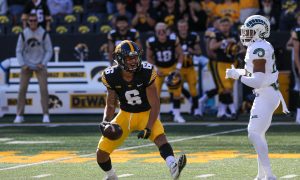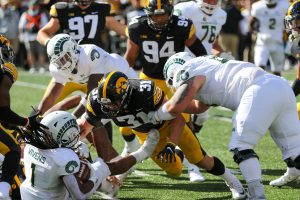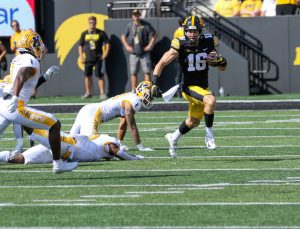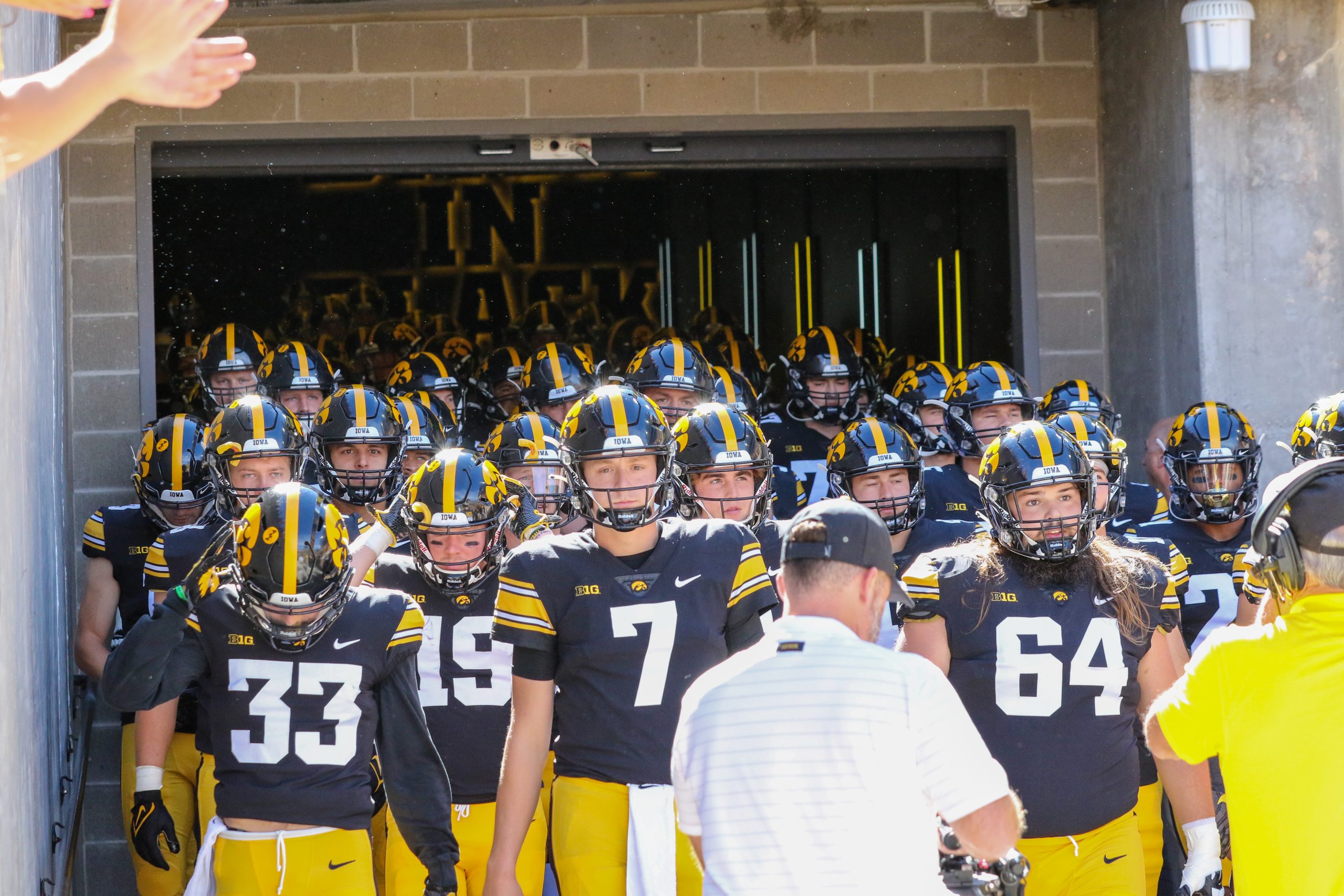Who holds the position advantages in Iowa’s Friday night matchup at Maryland
By Pat Harty
IOWA CITY, Iowa – Iowa and Maryland are both 4-0, but how they achieved that record shows that winning can be accomplished in different ways.
Friday’s game between the fifth-ranked Hawkeyes and the vastly improved Terrapins will match one of the Big Ten’s top defenses in Iowa against one of the conference’s top offenses in Maryland.
Iowa likes to play physical, while Maryland likes to play in space in order to take advantage of its speed and quickness at the skill positions.
Maryland has the kind of offense in which getting to the red zone isn’t necessarily a big deal, while Iowa would prefer to control the tempo with sustained drives featuring both the run and pass.
Iowa’s defense under Phil Parker is designed and built to limit big plays, while Maryland’s offense behind quarterback Taulia Tagovailoa is built to make big plays.
Here is a closer look at the nine position breakdowns and which team has the advantage.
Quarterback: Spencer Petras is coming off arguably his best game as a Hawkeye, and Iowa has won 10 straight games with him behind center dating back to last season. Petras passed for 224 yards and two touchdowns in last Saturday’s 24-14 victory over Colorado State. He also showed his ability to throw downfield against Colorado State with a 43-yard touchdown pass to freshman receiver Keagan Johnson, and a 49-yard completion to Johnson.
But Petras’ statistics pale in comparison to Maryland quarterback Taulia Tagovailoa, who leads the Big Ten in passing yards at 335 yards per game. Tagovailoa is also a threat to run, and he has been careful with the football, having thrown just one interception this season.
Petras also has thrown just one interception this season, and there is no substitute for winning. But Tagovailoa’s statistics, coupled with Maryland’s success, makes him an early candidate for Big Ten Offensive Player of the Year.
Advantage: Maryland
Running back: Both teams have a starting running back with big-play capability, and with similar statistics. Iowa junior Tyler Goodson has rushed for 364 yards and scored five touchdowns, while Maryland senior Tayon Fleet-Davis has rushed for 311 yards and is averaging 7.1 yards per carry.
Fifth-year senior Ivory Kelly-Martin gives Iowa one of the most experienced backup running backs in the conference. He started six games as a sophomore in 2018, has played extensively on special teams, and has 91 rushing yards on 24 attempts this season.
Kelly-Martin has struggled with ball security, losing fumbles against Indiana and Kent State, but he hasn’t lost the confidence and trust of his teammates and coaches.
This is a close call, but Goodson’s track record as a returning first-team All-Big Ten selection, and with how he has performed this season, stands out ever so slightly.
Advantage: Iowa

Wide receiver: The Terps are loaded at this position, with three explosive receivers, including Dontay Demus, who leads the Big Ten with 24 receptions for 446 yards and three touchdowns. Pay too much attention to him, however, and fellow receivers Rakim Jarrett and Jeshaun Jones will burn you. Rakim has 17 catches for 265 yards, while Jones has 15 catches for 201 yards and three touchdowns. All three receivers are dangerous in space and threats to score from anywhere on the field.
Iowa, on the other hand, has struggled to get its receivers involved. Big things were expected from junior Tyrone Tracy Jr., but he only has 10 catches for 72 yards and zero touchdowns. Freshman Keagan Johnson provided a big-play spark against Colorado State last Saturday with two catches for 92 yards, including a 43-yard touchdown.
Iowa has used six receivers this season, but that isn’t enough to offset Maryland’s quality at this position.
Advantage: Maryland
Tight end: Maryland has some talented players at this position, but Iowa has Sam LaPorta, who is flirting with stardom as a two-year starter. LaPorta leads all Big Ten tight ends with 17 receptions for 214 yards and two touchdowns. He and quarterback Spencer Petras have a strong connection on the field, and LaPorta also has a knack for getting open.
Freshman Luke Lachey has been a nice complementary piece as LaPorta’s backup. Lachey has two catches for 32 yards and is a good blocker.
Advantage: Iowa
Offensive line: This was another close call, partly because it’s still early, but also because Iowa has the best individual offensive lineman in junior All-America center Tyler Linderbaum, while Maryland has a slight edge as a group, partly due to having three returning starters from last season.
Maryland is also averaging 166.0 rushing yards per game, which is 45 more yards than Iowa averages on the ground.
Advantage: Maryland
Defensive line: And yet another close call. Iowa’s depth versus Maryland’s athleticism.
Iowa has used nine defensive linemen in a rotation, while Maryland is led by two of the conference’s top pass rushers in Durell Nchami and Sam Okuayinono.
You could argue this is a draw, but Iowa’s depth at these four positions, and its overall success as a defense, speaks loudly.

Advantage: Iowa
Linebacker: This is another case in which Maryland might be more athletic at these positions, but Iowa has the best players, especially in the case of junior Jack Campbell. The Cedar Falls native had a career-high 18 tackles against Colorado State, while his sidekick at linebacker, junior Seth Benson, had 11.
Campbell and Benson form one of the top one-two punches at linebacker in the Big Ten. They rank first and second on the team with 43 and 31 tackles, respectively, while sophomore linebacker Jestin Jacobs is third on team with 24 tackles.
Maryland has been hurt by injuries at this position, while Iowa is healthy for the most part, and being led by one of the best linebackers in the conference in Campbell.
Advantage: Iowa
Secondary: Maryland once again might have the advantage in athleticism at these positions, but Iowa has a better unit overall, due partly to experience, but mostly to execution.
Senior cornerbacks Riley Moss and Matt Hankins both have two interceptions, with both of Moss’s interceptions pick sixes.
Senior strong safety Jack Koerner is a sure tackler who rarely gets out of position, while junior Dane Belton is a rising star at the other safety position. Iowa often uses five defensive backs with hard-hitting junior safety Kaevon Merriweather replacing Jacobs in a 4-2-5 alignment.
Maryland also has experienced playmakers at these positions. Nick Cross and Jakorian Bennett both have two interceptions, and Bennett also ranks third in the conference with six pass breakups.

Photo – Rob Howe/HawkeyeFanatic.com
Advantage: Iowa
Specialists: Maryland might have a slight advantage at kicker where Joe Petrino has made all seven of his field-goal attempts. But Iowa has the edge at punter and in the return game.
Iowa sophomore Tory Taylor is averaging 47.9 yards on 27 punts, and was the Big Ten Punter of the Year as a freshman. Anthony Pecorella is averaging 44.1 yards per punt for Maryland, which is respectable, but nearly four yards less than what Taylor averages.
Charlie Jones also gives Iowa an edge in the return game as he ranks fifth in the conference in kick returns (24.4) and sixth in punt returns (13.4).
Advantage: Iowa



